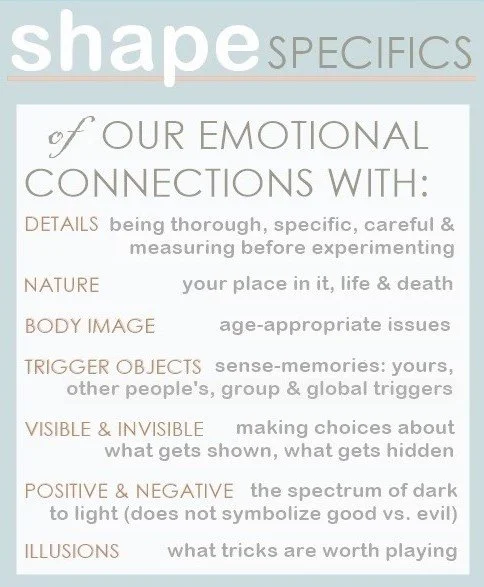shape
forms come from Shapes
Mentors and books always taught me to see forms -
the simple, standardized, geometric symbols
like circles and squares -
as our main building blocks of all visual work & nature;
but wouldn’t we say those forms are similar to DNA,
and are going to unpack
what was packed into them - like crystals -
we start with what the DNA will become;
I start all my work by focusing on individual shapes
with unique details -
I believe and see all forms as abstractions of specific, complex shapes.
The 4 Perspectives of Shape in Drawing
1 / Shapes of Your Living and Work Spaces
The complications of being overwhelmed by a universe of shapes -
start by creating a youniverse;
examine and edit what’s around you and in your memory -
what practical details impact your imagination?
2 / Shape of Your Drawing Surface
The complications of creating your own resistance on purpose -
of confining yourself, your ideas and attention to the limits, oppositions
of this object, this surface, and your tools for it -
but can you see your release in it?
3 / Shapes Within Your Drawing
The complications of dividing one shape, one surface, into many shapes -
relationships and ratios: drawing one shape creates partial edges of
other shapes, including blank/negative-space shapes;
does balance or emphasis matter most?
4 / Shapes of Formatting and Producing Your Drawing
The shape-shifting problems of product design -
how many different ways do you want to share and show your drawing?
Does it look best in a certain size, angle, lighting?
Will you create many incarnations of it from one good photograph?
Even if the only tool we
have is our body
& we can only draw,
dig or build in
the dirt, sand or snow -
we have enough to learn and work with,
to build and show
a full understanding of
how to
manipulate material
spaces into shapes -
recognizable or unknown -
to capture an
expression of our
awareness, opinions.
Shape Specifics
Details
being thorough, specific and careful, measuring before experimenting
Nature
your place in it; life and death cycles
Body Image
age-appropriate issues
Trigger Objects
sense-memories, yours and other people’s group and global triggers
Visible and Invisible
making choices about what gets shown, what gets hidden
Positive and Negative
the spectrum of dark to light (does not symbolise good vs. evil)
Illusions
what tricks are worth playing
These are the big, broad ideas of the Shape section in Workbook #4, and from here we break the ideas down from theory to application, into easier words through conversation & journaling - finding the shapes your concepts have been taking up in your mind.
Download the workbook pdf for free by clicking here (as soon as it’s ready - spring 2022) whether or not you’re registered in the program;
this is my library for you -
I would, and might eventually, put more of its content straight onto this website,
but I believe it’s better for you to sit somewhere away from technology with a print version, a pencil & an eraser.
Recommended Study Timeline: 1-2 Months
Month No. 5 in Workbook #6


































